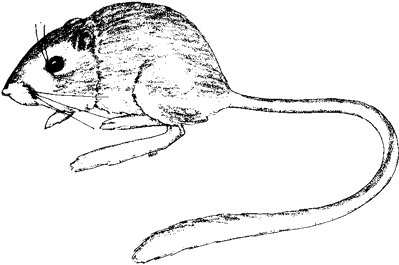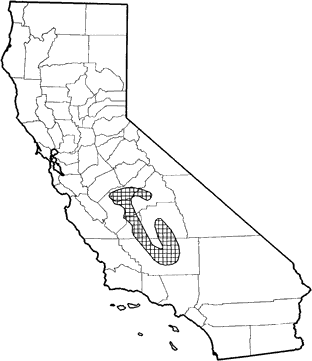
San Joaquin Kangaroo Rat
Distribution, Abundance, and Seasonality
Abundance data not available. Permanent resident of alkali desert scrub habitat and herbaceous habitats with scattered shrubs. Currently, found primarily in the southwestern San Joaquin Valley at elevations up to 550 m (1800 ft). The Fresno kangaroo rat (D. n. exilis) is the smallest of the three subspecies, and is Endangered (California Dept. Fish and Game 1980a). D. nitratoides is restricted to a few remaining alkali sink areas of marginal habitat. Its total remaining habitat area was estimated to be approximately 2023 ha (5000 ac) in 1980. Rapid urbanization, and agricultural developments associated with the State Water Project have extirpated this species from much of its historical range (California Dept. Fish and Game 1980a). The most dramatic habitat losses have been experienced by D. n. exilis.

Range Map
Specific Habitat Requirements
Feeding: Fresno kangaroo rats forage on open ground and under shrubs. They eat mainly seeds of annual forbs and grasses (e.g., brome grasses and wild oats). They also consume some green vegetation. Food is collected and stored temporarily in cheek pouches. Some food later cached in small holes, dug in sides of burrows (Culbertson 1946).
Cover: Fresno kangaroo rats use nearly level terrain with sandy loam soils for excavation of burrows. Herbaceous vegetation with scattered shrubs is common above-ground cover. Culbertson (1946) described burrow systems as covering a surface area from about 2.1 x 2.1 m (7 x 7 ft) to 3.7 x 3.7 m (12 x 12 ft). Some burrow systems included short dead-end tunnels, apparently used to escape predators.
Reproduction: Nests are in burrows excavated in sandy loam soils.
Water: Drinking water apparently is not required (Culbertson 1946).
Pattern: Little information available. Gently undulating to level terrain with sandy loam soils, mildly to moderately alkaline, and herbaceous vegetation with scattered shrubs, appears to be suitable habitat.
Species Life History
Activity Patterns: Yearlong nocturnal activity.
Seasonal Movements / Migration: Non-migratory.
Home Range: No data found.
Territory: No data found.
Reproduction: Breeding occurs from December through September (Hawbecker 1951, Eisenberg and Isaac 1963). Average litter size 2-3, range from 1-3 (Eisenberg and Isaac 1963). Young born and reared in burrows.
Niche: D. nitratoides is closely related to D. merriami (Ingles 1965), and probably similar in habits. It is sympatric in portions of its range with at least 7 other seed-eating heteromyid rodents (i.e., D. ingens, D. heermanni, D. elephantinus, Chaetodipus californicus, Perognathus inornatus, P. Iongimembris, and probably P. alticola). Potential competition for food and space may occur between D. nitratoides and these species. Seed-eating insects and birds also may compete for food. Badgers, kit foxes, owls, and snakes probably prey on these kangaroo rats.
Sources & References
California Department of Fish and Game, 1999.
California's Wildlife, Sacramento, CA.
Written by: G. Ahlborn, reviewed by: M. White, edited by: M. White
Boolootian, R. A. 1954. An analysis of subspecific variations in Dipodomys nitratoides. J. Mammal. 35:570-577. California Department of Fish and Game. 1980a. At the crossroads: a report on the status of California's endangered and rare fish and wildlife. Sacramento. 149pp. Culbertson, A. E. 1946. Observations on the natural history of the Fresno kangaroo rat. J. Mammal. 27:189-193. Eisenberg, J. F. 1963. The behavior of heteromyid rodents. Univ. Calif. Publ. Zool. 69:1-114. Eisenberg, J. F., and D. E. Isaac. 1963. The reproduction of heteromyid rodents in captivity. J. Mammal. 44:61-67. Grinnell, J. 1922. A geographical study of the kangaroo rats of California. Univ. Calif. Publ. Zool. 24:1-124. Hawbecker, A. C. 1951. Small mammal relationships in an Ephedra community. J. Mammal. 32:50-60. Ingles, L. G. 1965. Mammals of the Pacific states. Stanford Univ. Press, Stanford, CA. 506pp. Williams, D. F. 1986. Mammalian species of special concern in California. Calif. Dept. Fish and Game, Sacramento. Admin. Rep. 86-1. 112pp.
California Animal Facts | California's Wildlife